After trying to gather as much info on the Synergy horn topic as I could, I'm now trying to put it all together into a new project, meant to be coupled with the sub I built here.
After watching and listening to various Youtube videos, it had to be a Synergy horn design . But it is not so straightforward to design one, as you all probably know.
. But it is not so straightforward to design one, as you all probably know.
I'm shooting for 130dB SPL, as the speaker is meant to complement the sub and the whole system is to be used with an electric drum set, and must be suitable to play gigs with.
The BMS 4550 compression drivers seemed a sure thing, since they're used in several Tom Danley designs. So for the top end I'm decided on this driver (already bought 2). For mids, looking at availability, I'm not going to get my hands on the Celestion TF0410MR's, so when the Visaton M10 popped up as a usable driver, I happily chose this one for starters.
I haven't decided on woofers yet. I did some quick simulations in Hornresp, but since I started top down, my first objective was to get the mids done correctly/according to my needs.
Transport-wise there are some restrictions to the cabinets: I need to be able to place them in the aforementioned sub if I want to be able to put it all in my car. So dimension-wise, I'm limited to WxHxD=80x48x50 cm (or 31.5x18.9x19.7 inch).
So here's what I think should work:
1 BMS 4550,
4 Visaton M10s,
2 10" or 12" woofer, tbd,
in a 70x30 degree Synergy horn.
I'm using bwaslo's Spreadsheet (many thanks!):
I'm shooting for a tweeter-mid crossover @ 1000Hz and mid-woofer crossover @ 300Hz. Adding the path length of the BMS (6.7cm) and subtracting a throat adapter of 1.5cm, Con12 works out to 13.33... (am I doing this correctly? )
)
This results in the following response:
...with a phase response of:
Calculating max SPL:
...and the corresponding particle velocity at the mid ports:
Now this last one worries me . With all the graphs I've seen so far, particle velocity is largest in the lower frequencies, so what the f is going on here
. With all the graphs I've seen so far, particle velocity is largest in the lower frequencies, so what the f is going on here  . This is where I'm stuck at the moment, asking myself whether this design will do what it needs to. I'll probably be pushing some parameters around, hoping to find better results, but if anyone wnats to chip in, please do so
. This is where I'm stuck at the moment, asking myself whether this design will do what it needs to. I'll probably be pushing some parameters around, hoping to find better results, but if anyone wnats to chip in, please do so  . I'm eager to learn.
. I'm eager to learn.
After watching and listening to various Youtube videos, it had to be a Synergy horn design
I'm shooting for 130dB SPL, as the speaker is meant to complement the sub and the whole system is to be used with an electric drum set, and must be suitable to play gigs with.
The BMS 4550 compression drivers seemed a sure thing, since they're used in several Tom Danley designs. So for the top end I'm decided on this driver (already bought 2). For mids, looking at availability, I'm not going to get my hands on the Celestion TF0410MR's, so when the Visaton M10 popped up as a usable driver, I happily chose this one for starters.
I haven't decided on woofers yet. I did some quick simulations in Hornresp, but since I started top down, my first objective was to get the mids done correctly/according to my needs.
Transport-wise there are some restrictions to the cabinets: I need to be able to place them in the aforementioned sub if I want to be able to put it all in my car. So dimension-wise, I'm limited to WxHxD=80x48x50 cm (or 31.5x18.9x19.7 inch).
So here's what I think should work:
1 BMS 4550,
4 Visaton M10s,
2 10" or 12" woofer, tbd,
in a 70x30 degree Synergy horn.
I'm using bwaslo's Spreadsheet (many thanks!):
An externally hosted image should be here but it was not working when we last tested it.
I'm shooting for a tweeter-mid crossover @ 1000Hz and mid-woofer crossover @ 300Hz. Adding the path length of the BMS (6.7cm) and subtracting a throat adapter of 1.5cm, Con12 works out to 13.33... (am I doing this correctly?
 )
)An externally hosted image should be here but it was not working when we last tested it.
This results in the following response:
An externally hosted image should be here but it was not working when we last tested it.
...with a phase response of:
An externally hosted image should be here but it was not working when we last tested it.
Calculating max SPL:
An externally hosted image should be here but it was not working when we last tested it.
...and the corresponding particle velocity at the mid ports:
An externally hosted image should be here but it was not working when we last tested it.
Now this last one worries me
Hmm, I already spotted some mistakes... When calculating for maximum SPL, Hornresp seems to ask for the maximum power per speaker, not for maximum total power  . So here are the corrected graphs:
. So here are the corrected graphs:



Now it seems there is no problem, since the generally accepted limit of 17 m/s is never reached, not even close.
SPL is at 127dB peak with 100W going into each mid unit, so two horns should be able to do 130dB easily, with 3dB headroom. As far as my head calculations go, that's half of the max power @130dB, so 50W/speaker, or 200W total power per box for the mids.
Looks like it's a green light for the first proto .
.
The only thing that bothers me a little, is the dip around 700Hz... that corresponds to almost exactly double the length of the whole horn. Could it be some 1/2 wavelength cancellation 'notch'?
 . So here are the corrected graphs:
. So here are the corrected graphs:


Now it seems there is no problem, since the generally accepted limit of 17 m/s is never reached, not even close.
SPL is at 127dB peak with 100W going into each mid unit, so two horns should be able to do 130dB easily, with 3dB headroom. As far as my head calculations go, that's half of the max power @130dB, so 50W/speaker, or 200W total power per box for the mids.
Looks like it's a green light for the first proto
The only thing that bothers me a little, is the dip around 700Hz... that corresponds to almost exactly double the length of the whole horn. Could it be some 1/2 wavelength cancellation 'notch'?
125dB is considered by many to be the onset of pain. Why do you need 130dB? You need big mid entry ports to get anywhere near 130dB.
Well, honestly, I thought the pain limit was at 120dB, but anyway...
I trust you have heard a snare drum sometime 'in real life'. I have not measured the peak SPL of my snare drum, but I would say it's not that hard to hit it and make you ears hurt. Suffice it to say I looooveeee my ear protection buds when I'm playing
So in order to be able to produce a 'live sound feel', I'd prefer to be sure I have the headroom available, if needed.
In the sub-build thread I elaborate on my idea for this set. In short: I'd like to use an edrum set coupled to software like Toontrack Superior Drummer or Addictive Drums for live gigs, instead of an acoustic set. The pros: way better sound, easily adjustable and controllable. The cons: there's no such thing on the market, I have to do it from scratch. But that's part of the fun
[edit]
Oh, and the SH50 does 130dB, so it should be feasible
Last edited:
I think you're going to have trouble getting rid of that strong output above 1kHz unless you use a very high order crossover.
That's a good observation. However, Hornresponse sometimes calculates the peaks to be higher than what they measure in real life. I would still move ahead with the build and measure it to see if the peaks are really that high. If they are, then you can increase the front mid chamber volume to act as a more effective low pass filter.
I think you're going to have trouble getting rid of that strong output above 1kHz unless you use a very high order crossover.
Thanks for the heads up. I already simmed an active crossover 8th order@1000Hz, which dropped the bump 20dB below average.That's a good observation. However, Hornresponse sometimes calculates the peaks to be higher than what they measure in real life. I would still move ahead with the build and measure it to see if the peaks are really that high. If they are, then you can increase the front mid chamber volume to act as a more effective low pass filter.
I also simmed a bigger Vtc, but that barely gave any (good) results. A smaller Vtc however, seemed to push the out-of-band bump down a little
I think I'll just start a proto and measure. But first I have to figure out if the mids will fit physically in the horn
 .
.Just to be sure: the Conxx length is measured through the center of the horn, not alongside the horn sides, is it? (it would result in two different path lengths if it would be measured alongside the horn sides, but I'm still asking just so I don't err here).
Thanks!Its down the center axis of the horn.
It turned out placing the drivers was impossible, the mid ports were too far apart in the horn top and bottom. So it was back to the drawing board...
... and this is what came out

I switched to 6 drivers, because of the relatively low efficiency of the M10's.

Muuuccchhh better
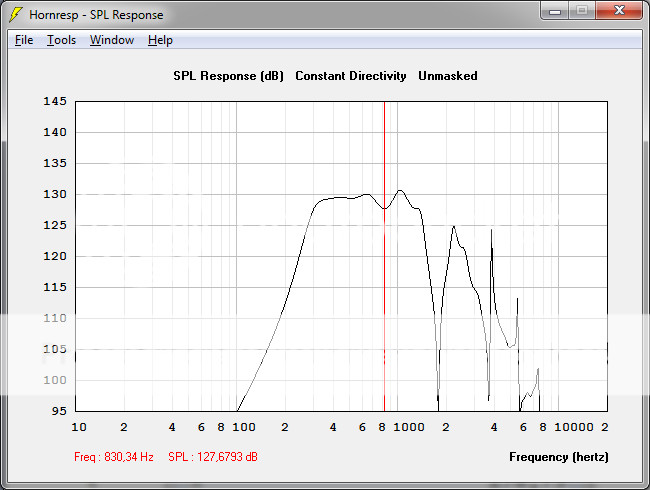
Particle velocity looks fine...
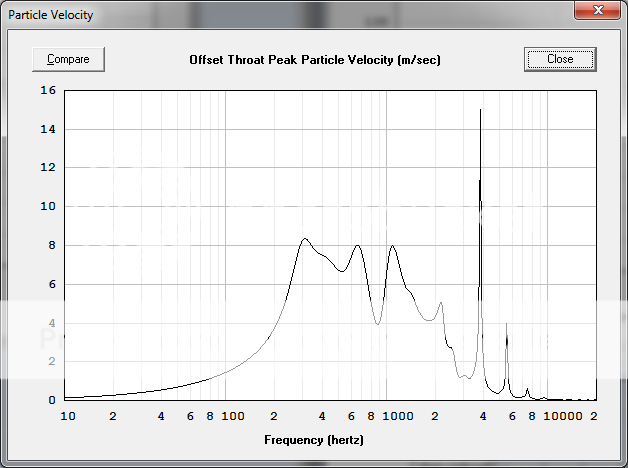
No problems here either...
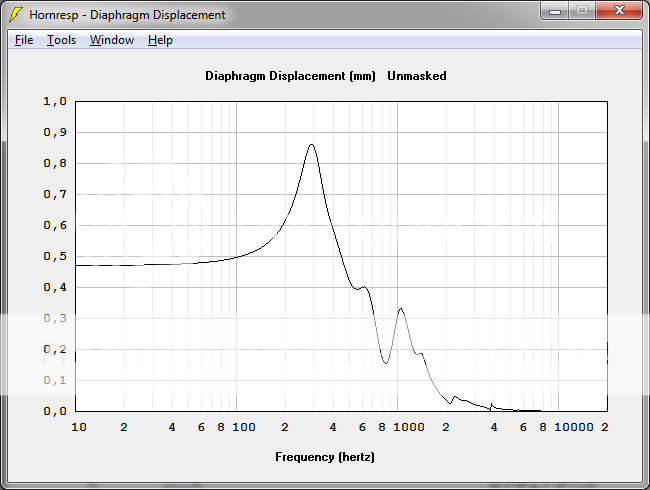
And even the impulse response looks acceptible (at least to my eyes).
 .
.Would you say this is worth trying?
ok, I admit, I still have to (try to) lay it out on the horn, but it looks doable

Hmm, it's going to be tricky, but I think it'll work...
I had a look at the Eminence Delta-12LFA for the woofer part. The sims turn out great with two of them! I feel I'm in luck . Unless someone discovers a flaw in my sims
. Unless someone discovers a flaw in my sims  . Here's some graphs:
. Here's some graphs:
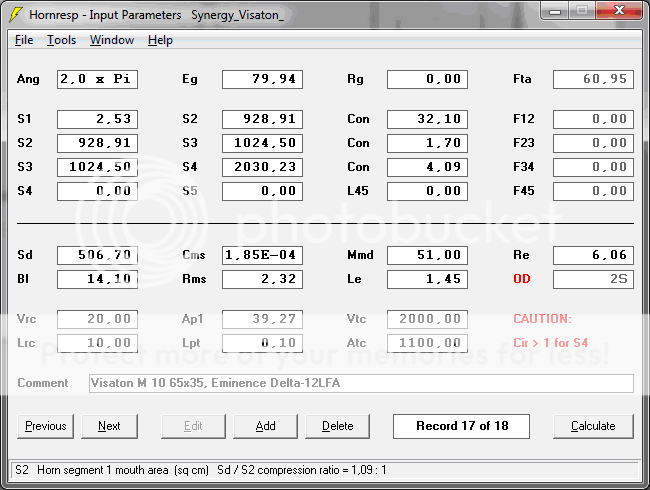
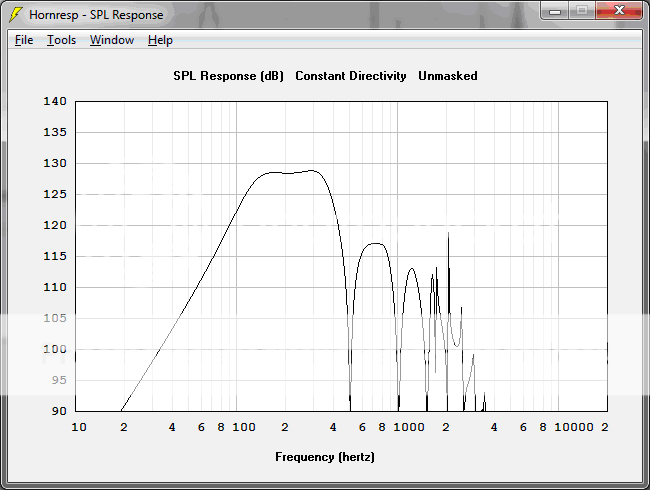
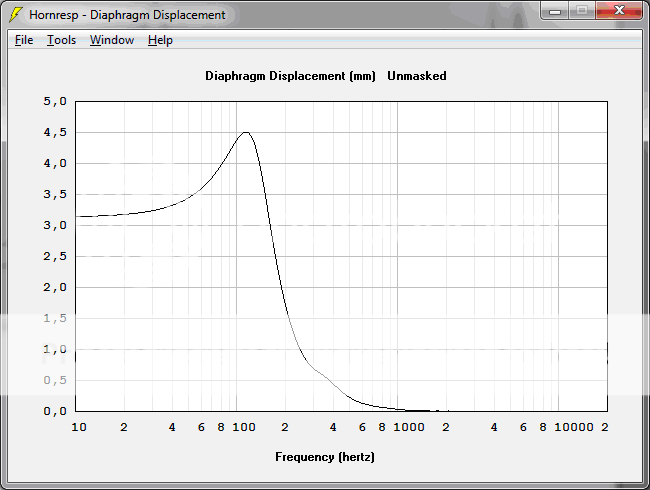
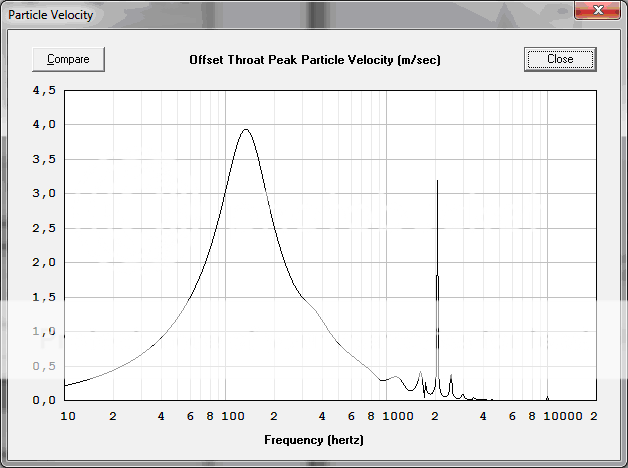
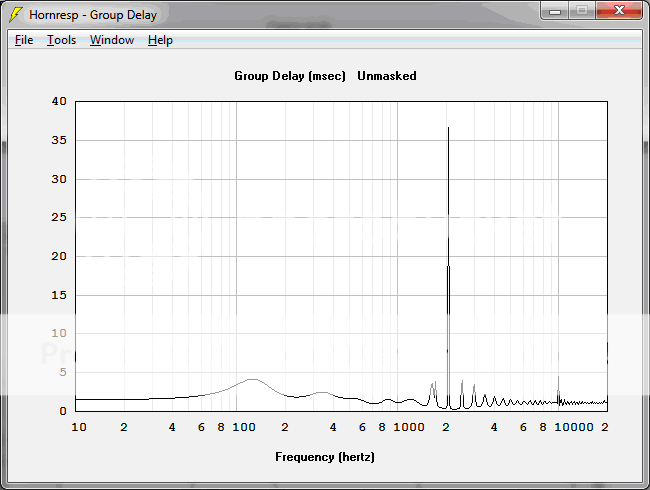
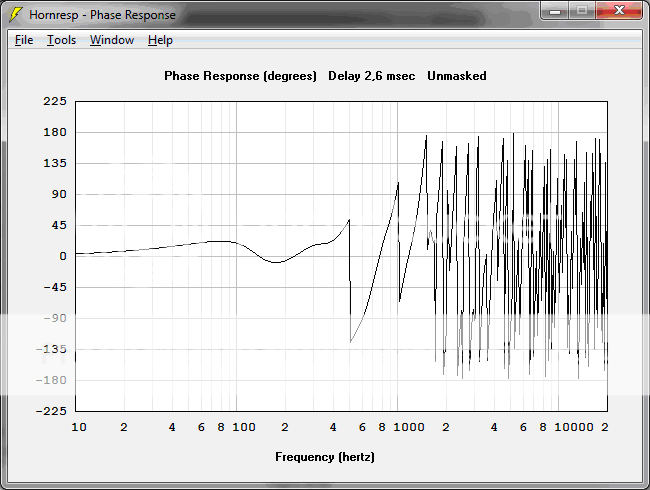
An externally hosted image should be here but it was not working when we last tested it.
I had a look at the Eminence Delta-12LFA for the woofer part. The sims turn out great with two of them! I feel I'm in luck






The woofer choice in a Synergy horn is not that critical. If it simulates half way decent, then it will be fine. It is actually better to use a less expensive woofer with a weaker motor because your bigger problem is getting the woofer to "turn off" so it doesn't interfere with the mid. Cheap woofers are perfectly fine.
Well, the Delta-12LFAs isn't particularly expensive, like some RCF and B&C drivers are... Plus they seems to turn off nicely in the sims, although its motor is not particularly weak at 14.1 Tm.
I'm questioning the sims of the mids, though. When I enlarged Ap1 (the size of the mid-tap holes), nothing changed in the Particle Velocity graph. Same thing when I made them very small. I would expect a smaller tap hole would result in a higher particle velocity, am I wrong? Or is it because of the small port length (LPT)? I was planning on some decent frustrums... (I used v32.20 & 32.40, the latest version of Hornresp).
I'm questioning the sims of the mids, though. When I enlarged Ap1 (the size of the mid-tap holes), nothing changed in the Particle Velocity graph. Same thing when I made them very small. I would expect a smaller tap hole would result in a higher particle velocity, am I wrong? Or is it because of the small port length (LPT)? I was planning on some decent frustrums... (I used v32.20 & 32.40, the latest version of Hornresp).
Well, the Delta-12LFAs isn't particularly expensive, like some RCF and B&C drivers are... Plus they seems to turn off nicely in the sims, although its motor is not particularly weak at 14.1 Tm.
I'm questioning the sims of the mids, though. When I enlarged Ap1 (the size of the mid-tap holes), nothing changed in the Particle Velocity graph. Same thing when I made them very small. I would expect a smaller tap hole would result in a higher particle velocity, am I wrong? Or is it because of the small port length (LPT)? I was planning on some decent frustrums... (I used v32.20 & 32.40, the latest version of Hornresp).
You are correct; the larger ports will result in lower velocities. I personally don't use Hornresp for velocity sims; I use Akabak.
Sawdust  .
.
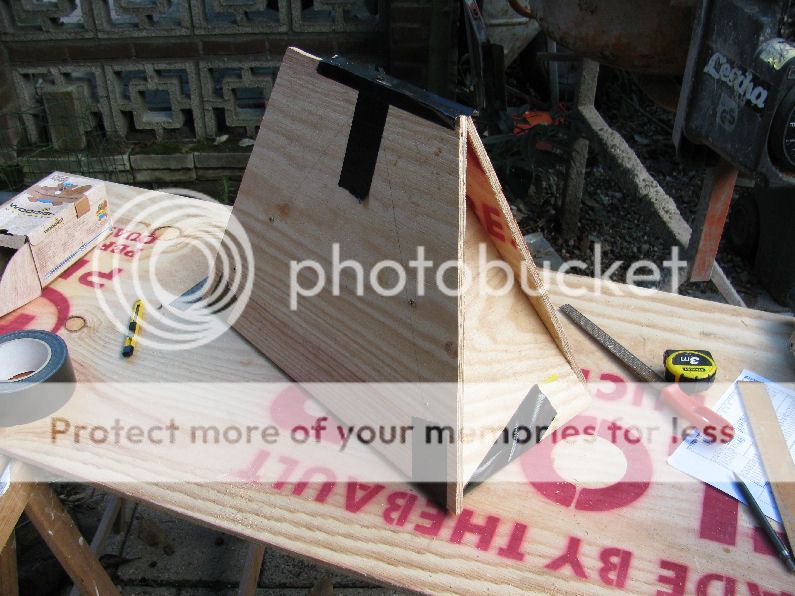
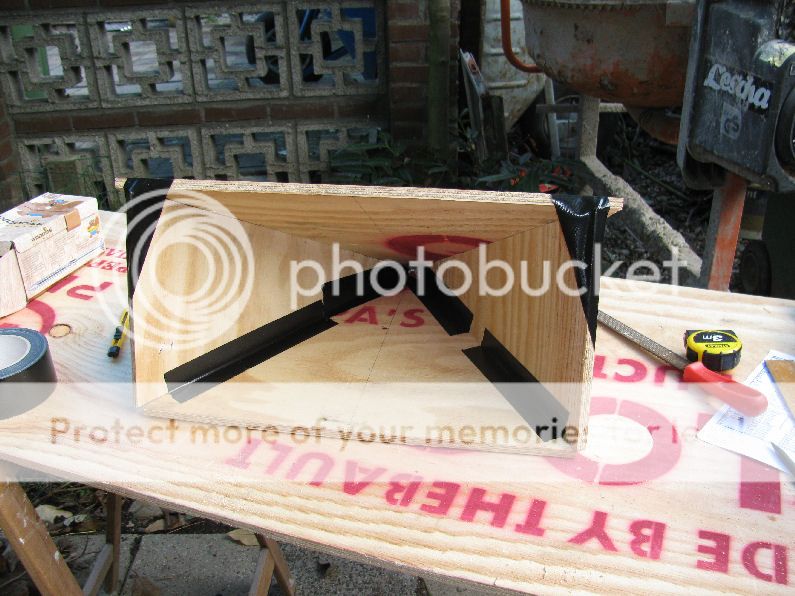

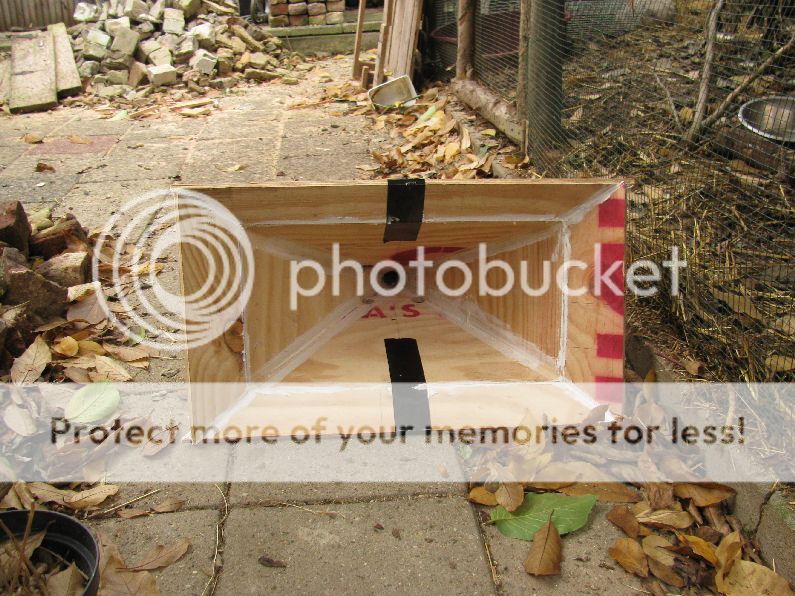

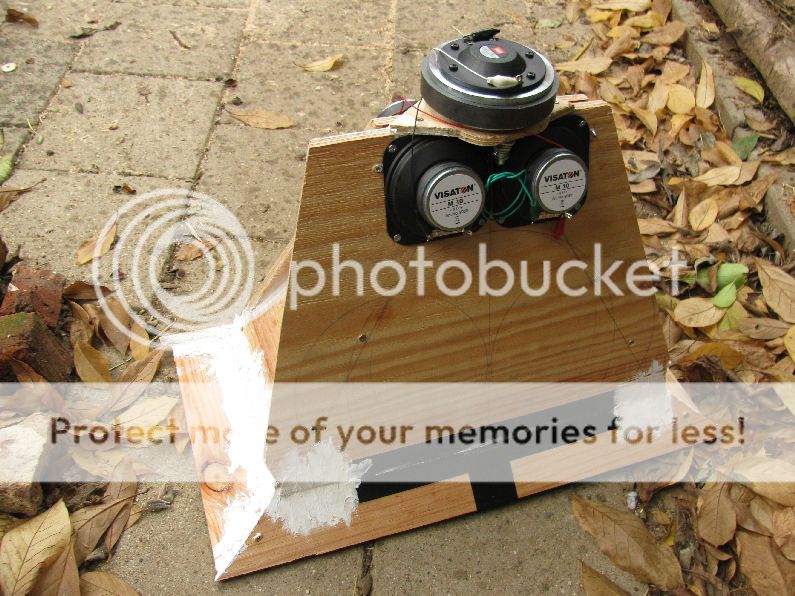
Since this is a proto, I didn't us PU glue, but ordinary kit. That way I can dissamble the thing with relative ease and use the parts as a template.
As you can see, at the moment there are only 4 mids mounted. I'm still planning on 6, but I only had 4 at hand. Preliminary testing suggests 6 wouldn't be a bad idea considering the efficiency of the compression driver.
Now I run into another problem: A 12" woofer won't fit on the side. So it's either back to 2x10" or 4x8", or.... I need to come up with a construction to fit the 12s. The only way I see that happening, is with a bigger front chamber and an extra mounting plate. Let's try to sim that .
.






Since this is a proto, I didn't us PU glue, but ordinary kit. That way I can dissamble the thing with relative ease and use the parts as a template.
As you can see, at the moment there are only 4 mids mounted. I'm still planning on 6, but I only had 4 at hand. Preliminary testing suggests 6 wouldn't be a bad idea considering the efficiency of the compression driver.
Now I run into another problem: A 12" woofer won't fit on the side. So it's either back to 2x10" or 4x8", or.... I need to come up with a construction to fit the 12s. The only way I see that happening, is with a bigger front chamber and an extra mounting plate. Let's try to sim that
 .
.I took some measurements (still with only the 4 mid drivers):

Red = Mids only, no filters,
Blue = High only, no filters, same power applied as in red curve,
Yellow = 2.83V , mids filtered HP: @249Hz/But24, LP: @1k/But24; high HP @1k But24 (this clipped my mic input, so the top of the curve should actually go even higher),
Green = Mids&tops, filtered and EQ'ed (using a DCX2496 and REW's RTA function and white noise generator for a flat curve).
All measurements @1m on axis, mic SPL calibrated using DEQ2496 SPL meter/ECM8000 measurement mic.
It's starting to look like it's going to work . With the EQ dialed in and the filters set it's already nice to listen to. Bad/distorted recordings are easily recognized
. With the EQ dialed in and the filters set it's already nice to listen to. Bad/distorted recordings are easily recognized  ...
...
I can't wait to find a solution for the woofer problem .
.

Red = Mids only, no filters,
Blue = High only, no filters, same power applied as in red curve,
Yellow = 2.83V , mids filtered HP: @249Hz/But24, LP: @1k/But24; high HP @1k But24 (this clipped my mic input, so the top of the curve should actually go even higher),
Green = Mids&tops, filtered and EQ'ed (using a DCX2496 and REW's RTA function and white noise generator for a flat curve).
All measurements @1m on axis, mic SPL calibrated using DEQ2496 SPL meter/ECM8000 measurement mic.
It's starting to look like it's going to work
I can't wait to find a solution for the woofer problem
I am confident the Visaton M10 is going to work out well, so I ordered 8 more (2 for this proto and 6 for producing the final stereo set.
The woofer part is giving me troubles, though. The Delta-12LFA would probably work, but the top and bottom of the horn need to be fitted with a mounting baffle and that will probably make the height dimension too large, more than 48cm, but it's hard to measure without the actual thing on hand. Putting the woofers on the sides will make the box too wide to fit two of them in the sub . I'll start looking for a similar driver with a smaller depth...
. I'll start looking for a similar driver with a smaller depth...
The woofer part is giving me troubles, though. The Delta-12LFA would probably work, but the top and bottom of the horn need to be fitted with a mounting baffle and that will probably make the height dimension too large, more than 48cm, but it's hard to measure without the actual thing on hand. Putting the woofers on the sides will make the box too wide to fit two of them in the sub
Hi Eric,
Thanks again for the advice and help with the sub/drumrizer .
.
I think 6 M10's in one box will survive. At least I hope so . The driver itself doesn't look too bad, looking at its price (I found them for €13 each). Early testing with the proto with only 4 of them yielded about 115dB with 10Vac - without woofers or the sub. I'm not sure yet how far I can push the M10's, but we'll see. I'm picking up 8 more, so hopefully I'll be able to install the last two on the proto tomorrow.
. The driver itself doesn't look too bad, looking at its price (I found them for €13 each). Early testing with the proto with only 4 of them yielded about 115dB with 10Vac - without woofers or the sub. I'm not sure yet how far I can push the M10's, but we'll see. I'm picking up 8 more, so hopefully I'll be able to install the last two on the proto tomorrow.
At the moment I still have a hard time finding (affordable) woofers that meet my specs, SPL- as well as dimension-wise. I've been looking at the Faital Pro 8FE200's, mentioned in the 'suitable midrange cone'-thread, but they don't sim nice . Too much response above 300Hz. Or I'm just really off with my simulations.
. Too much response above 300Hz. Or I'm just really off with my simulations.
The Eminence Beta 12A is 11.6cm deep, 2cm less than the Delta-12LFA, and it looks like it would actually fit. It doesn't sim really nice, but maybe it'll do... I'd really value some input on the matter, before I order two €75 ($105) that turn out unusable . Here are some sims:
. Here are some sims:
Yeah, I know, this is just the horn sim part. If I implement back chamber vents, I may be able to get even more low output, which would be nice to cover the hole between the sub .
.
Any suggestions and/or opinions are welcome .
.
Thanks again for the advice and help with the sub/drumrizer
I think 6 M10's in one box will survive. At least I hope so
At the moment I still have a hard time finding (affordable) woofers that meet my specs, SPL- as well as dimension-wise. I've been looking at the Faital Pro 8FE200's, mentioned in the 'suitable midrange cone'-thread, but they don't sim nice
The Eminence Beta 12A is 11.6cm deep, 2cm less than the Delta-12LFA, and it looks like it would actually fit. It doesn't sim really nice, but maybe it'll do... I'd really value some input on the matter, before I order two €75 ($105) that turn out unusable
 . Here are some sims:
. Here are some sims:An externally hosted image should be here but it was not working when we last tested it.
An externally hosted image should be here but it was not working when we last tested it.
An externally hosted image should be here but it was not working when we last tested it.
An externally hosted image should be here but it was not working when we last tested it.
Yeah, I know, this is just the horn sim part. If I implement back chamber vents, I may be able to get even more low output, which would be nice to cover the hole between the sub
Any suggestions and/or opinions are welcome
Thijs,The Eminence Beta 12A is 11.6cm deep, 2cm less than the Delta-12LFA, and it looks like it would actually fit. It doesn't sim really nice, but maybe it'll do...
Yeah, I know, this is just the horn sim part. If I implement back chamber vents, I may be able to get even more low output, which would be nice to cover the hole between the sub.
Drum riser/sub, my old friend Steve Raitt (r.i.p.) did that back in the 1980s, fun. Actually brought his along from Minneapolis, Minnesota, on a tour of Europe.
The Beta 12A response looks good, and if your sub matches the sims (why no measurements?) and you "haystack" the bottom, porting should not be needed, though time alignment will be, of course.
A non phase inversion top (sealed rather than BR) is usually easier to get a good transition in the acoustical crossover region of around 100 Hz that you are looking at.
Art
Try the cheap 6.5 in polycone buyout driver from PE for the woofer - it sims well and has nice flat response with bass down to 50 Hz (sealed box) and reach up to 1 kHz. You can have a two way. The drivers are less than $5 ea and qnty 4 will get you to 89 to 91 dB efficiency.
http://www.diyaudio.com/forums/multi-way/244890-synergy-horns-dayton-prv-5.html#post3687739
http://www.diyaudio.com/forums/multi-way/244890-synergy-horns-dayton-prv-5.html#post3687739
Last edited:
- Status
- This old topic is closed. If you want to reopen this topic, contact a moderator using the "Report Post" button.
- Home
- Loudspeakers
- Multi-Way
- Synergy with BMS 4550, Visaton M10 and ...